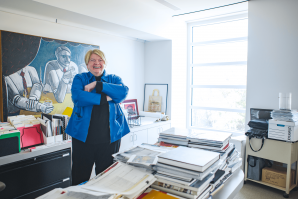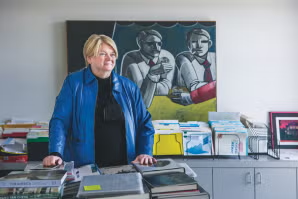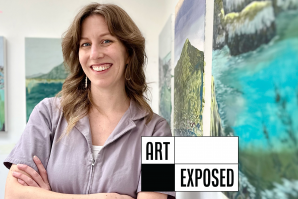Agustin Arteaga was talking about what he’d done in his eight years as executive director for the Dallas Museum of Art, trying to make it more inclusive and accessible.
And then Arteaga stopped himself, making sure to say the word “Sacramento” rather than “Dallas,” in an interview he was giving following the announcement on April 7 that he will become the new Mort and Marcy Friedman Director & CEO for the Crocker Art Museum.
“My city is Sacramento,” Arteaga says. “You have to learn to leave the things behind and own the new one.”
Arteaga will start July 1 in his role with the Crocker. He takes over for longtime leader Lial Jones, who announced last year that she would be retiring after roughly 25 years in her role.
The Crocker’s incoming leader brings a wealth of accomplishment and stints with museums in three countries. It’s a resume that won over the Crocker’s board through a nationwide hiring process that began more than a year, according to board president and Western Health Advantage CEO Garry Maisel.
“What brought Agustin to the forefront through many, many rounds of interviews, I’d say, is that basically, he’s globally recognized and he’s got an incredible track record,” Maisel says.
A global career in the arts
Born in Mexico City, Arteaga arrives in Sacramento after a long and varied career.
Arteaga was previously director of the Dallas Museum of Art, which he joined in 2016. Prior to this, Arteaga served as director of Mexico’s Museo Nacional de Arte and the Museo de Arte de Ponce in Puerto Rico and was founding director of Argentina’s Museo de Arte Latinoamericano de Buenos Aires.
Some of Arteaga’s cultural heritage has factored into his work over the years, with Dallas Magazine noting how he brought the works of Diego Rivera and Frida Kahlo to the museum there. Arteaga also led a bilingual initiative for the museum, as he tells Comstock’s. “I saw that Dallas had almost 40 percent of the population … mostly from Mexico and Latin America, and that there was no Spanish signage or text on the walls or anything,” Arteaga says. “And I said, well, if we really want to have that community coming over, we probably should be more mindful about how we can host them and welcome them.”
In recent years, Crocker has made great strides in bolstering its collection of work from Black artists, helped in part by financial support from Simon Chiu, a Southern California businessman who is now part of the museum’s board. Arteaga’s hiring could continue the museum’s evolution toward having a diverse array of programming and displayed works.
“I’ve been running institutions … that held collections of old masters, European masters,” Arteaga says. “I worked a lot with contemporary art nationally, which means from the U.S. And internationally, I’ve worked with institutions that have encyclopedic collections like Dallas, with African art or Oceania and pre-Columbian. So I like to have the opportunity of expanding the vision and the breadth of the exhibitions in a way that we make art accessible to everybody in Sacramento.”
Inclusivity has long been an important value for Arteaga. When he was hired for his Dallas job in 2016, he told the New York Times, “My goal has always been to show, through objects, how we are more alike than different.”
Maisel says that Arteaga’s record for diversity, innovation and accessibility also helped draw the board to him.
Tax filings for the museum, a nonprofit, show Arteaga’s tenure in Dallas was largely a success financially, though it wasn’t perfect. The Dallas museum suffered a break-in in 2022 where its alarms failed to go off, with Arteaga unsuccessfully seeking $85 million thereafter for facility maintenance. Arteaga later scaled his request back to $36 million and ultimately received $20 million from the city of Dallas, according to local reporting.
In reference to the break-in, a Crocker representative said via email, “Nothing was stolen but a few pieces were damaged, all have been restored and are back in view in their gallery. The DMA took prompt action, engaged outside consultants to evaluate, updated (systems) and procedures, and created a new position dedicated to leading security.”
The Dallas museum announced last year that Arteaga would be leaving at the end of 2024. Jeff Ellerman, the current board chairman, told Comstock’s when he was reached by phone, “I really have no comment, I’m sorry to say.”
Still, any problems Arteaga encountered in Dallas didn’t hinder Crocker’s board, with Maisel saying that Arteaga was honest and open. “He was always very well-spoken and very thoughtful in his answers, which we really appreciated,” Maisel says. He adds that there was discussion during the hiring process about how hard it had been for art museums during the pandemic. Maisel also says that the city of Sacramento’s financial support, which it provided to arts organizations through CARES Act funding was critical to the Crocker during this time.
Arteaga comes to town with no children or pets, he says, and with plans to live somewhere near the Crocker, though he isn’t sure where just yet. “It all looks like paradise,” he says. His husband of nearly 30 years, Carlos Gonzalez-Jaime, who is the CEO of an organization called Transform 1012 N. Main Street, will remain in Texas. Arteaga says it won’t be the first time they’ve lived apart and that he already knows the flight time between Sacramento and Dallas.
“Three hours and 40 minutes,” Arteaga says. “That’s not that bad.”
A legacy of leadership
To Dennis Mangers, a former California State Assemblyman and longtime supporter of local arts organizations, his friend Lial Jones has been “a real gift” for Sacramento.
“She’s gotten herself involved way beyond the museum,” Mangers says. “She’s a senior fellow in the American Leadership Forum and exerts her leadership regionally in various ways that are meaningful. … In spite of the current antipathy toward diversity and inclusion, she’s seen to it, to the extent of her capability, that the staff and everyone involved in the museum exhibits kind of a broader perspective of people who live in the region.”
It’s not unheard of for people to become institutions in Sacramento’s arts world. Richard Lewis was the president and CEO of Broadway Sacramento and Music Circus for more than 50 years before his retirement in 2023. Ron Cunningham served as co-artistic director of the Sacramento Ballet for 30 years before departing that role in 2018, with his wife Carinne Binda serving as co-artistic director nearly the entire time.
Jones has now served for an almost equally long time leading the Crocker. The museum’s board wasn’t necessarily looking to replicate this in its search for her replacement. “No one expects that we’re ever going to have a leader at the Crocker that serves the tenure of Lial,” Maisel says. “That is unheard of in the museum industry.”
Jones says the average tenure for directors is eight years.
“For a lot of people, they look at moving up in their career by moving,” Jones says. “There’s a lot of room for growth in individual institutions. So moving from one institution to another is a pretty typical way. That hasn’t been my primary motivator.”
Instead, Jones’ motivators have been making lasting community impact and generational impact. During her time, the museum has expanded significantly in size, background of artists and the size of its endowment, which according to Maisel reached $50 million in recent years. “I call Lial the founder of the modern Crocker,” Maisel says.
Arteaga doesn’t come into Sacramento as an unknown to Jones, who says the museum world is small. They’ve known one another for approximately 20 years and are both members of the Association of Art Museum Directors. “I think he’s thoughtful, friendly,” says Jones, who didn’t participate in the search to hire Arteaga. “The comments he makes are well-reasoned.” Jones plans to work until August, with some overlap after Arteaga begins.
As for Arteaga, he’s excited for the chance to learn. “You really have to have your feet in the ground and have ears on the ground and see what is really important and relevant for your community, for your staff and for your stakeholders,” Arteaga says. “We’ll work together putting (together) a strategic plan and we’ll define what is the roadmap to success for the next level.”
He adds, “The bar is pretty high with what Lial has done. So we’ll work all together to accomplish that.”
–
Subscribe to the Comstock’s newsletter today.
Recommended For You

A Quarter-Century at the Museum
Retiring Crocker Art Museum CEO reflects on tenure
Lial Jones, who is the Mort and Marcy Friedman director and CEO for the museum, announced recently that she’ll retire at the end of this year. In her tenure, she’s overseen the expansion of both Crocker’s collection and the museum itself.

The Way We Work: Lial Jones
A glimpse into the daily life of Crocker Art Museum CEO Lial Jones
Each issue, we dig into the working habits of a top executive in the Capital Region, providing insight into how they get things done.

Art Exposed: Jennifer Peart
Meet the Sacramento artist painting portals to a sustainable future
Addressing themes of reciprocity and stewardship, Jennifer Peart’s artwork draws inspiration from science fiction novels, retrofuturistic architecture and pristine natural landscapes. Her intricate, vivid landscapes, often featuring familiar landmarks, are delicately painted on sustainably sourced wood panels.

Art Exposed: Julie Bernadeth Crumb
Weaving cultural memory and communal care into artistic practice
Whether creating elaborate jewelry inspired by pre-colonial harvest rituals, collaging woodcut prints into an altar homage to her Filipino homeland or sculpting clay into aquatic life forms for an underwater installation, award-winning multidisciplinary artist Julie Bernadeth Crumb uses her hands to forge materials into meditations on culture, identity and Indigeneity.



